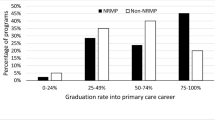Abstract
OBJECTIVE: Medical educators have attempted in recent years to provide quality clinical experiences for medical students early in their medical training. We questioned whether participating in a preceptorship in internal medicine (PIM) resulted in better performances on subsequent clinical rotations and increased interest in internal medicine.
PARTICIPANTS: Fifty-four students have participated in the PIM to date, with control groups consisting of students who applied for it but were not selected (n=36), students participating in a preceptorship in family medicine (n=168), and the remaining students (n=330).
DESIGN: Prospective cohort study.
SETTING: University medical center and community practices.
INTERVENTION: A 2-month, clinical preceptorship following the first year of medical school.
MEASUREMENTS AND MAIN RESULTS: The following outcomes were assessed: scores in the introduction to clinical medicine course; grades in the medical ethics course; scores from the internal medicine clerkship; and choosing a career in internal medicine. In their second year, PIM students scored higher in both semesters of the introduction to clinical medicine course (87% and 86% vs 84% and 84%, p’s<.01) and were more likely to receive honors in ethics (50% vs 29%, p<.01) than non-PIM students. During the internal medicine clerkship, PIM students’ scores were significantly higher on an objective structured clinical examination (79% vs 76%, p=.05), ambulatory clinical evaluations (80% vs 76%, p<.01), and overall clerkship scores (78% vs 75%, p=.03) but not on inpatient clinical evaluations or on the National Board of Medical Examiners Subject Examination. Preceptorship students were more likely to receive honors grades in the medicine clerkship (33% vs 10%, p<.01), and they were more likely to match into internal medicine residencies than control students (54% vs 27%, p<.01).
CONCLUSIONS: The PIM course is an intervention, early in students’ careers, which appears to benefit them academically and increase their interest in internal medicine as a career.
Similar content being viewed by others
References
Flannery MT, Altus P, Wallach PM. The Ides of March: the match of 1993 in perspective. Arch Intern Med. 1994;154:796–8.
Randlett RR, Creighton KP. Results of the National Resident Matching Program for 1996. Acad Med. 1996;71:697–9.
Schwartz MD, Linzer M, Babbott D, Divine GW, Broadhead E. Medical student interest in internal medicine. Ann Intern Med. 1991;114:6–15.
Babbott D, Levey GS, Weaver SO, Killiam CD. Medical student attitudes about internal medicine: a study of U.S. medical school seniors in 1988. Ann Intern Med. 1991;114:16–22.
Henderson MC, Hunt DK, Williams JW. General internists influence students to choose primary care careers: the power of role modeling. Am J Med. 1996;101:648–53.
Wright S, Wong A, Newill H. The impact of role models on medical students. J Gen Intern Med. 1997;12:53–6.
Williams GC, Wiener MW, Markakis KM, Reeve J, Deci EL. Medical students’ motivation for internal medicine. J Gen Intern Med. 1994;9:327–32.
McMurray JE, Schwartz MD, Genero NP, Linzer M. The attractiveness of internal medicine: a qualitative analysis of the experiences of female and male medical students. Ann Intern Med. 1993;119:812–8.
Schwartz MD, Linzer M, Babbott D, Divine GW, Broadhead E. The impact of an ambulatory rotation on medical student interest in internal medicine. J Gen Intern Med. 1995;10:542–9.
Black MG, Fincher RE, Kuske TT. Providing clinical experience to first-year students. Acad Med. 1993;68:613–4.
Albannese MA, Mitchell S. Problem-based learning: a review of literature on its outcomes and implementation issues. Acad Med. 1993;68:52–80.
Albritton TA, Fincher RE, Mutha S, et al. Internal medicine student clubs in U.S. medical schools. J Gen Intern Med. 1996;11:438–9.
Lipkin M. Career attractiveness of general internal medicine. SGIM News. 1992;15.
Wagner JM, Ainsworth M, Elnicki DM. Internal medicine preceptorships: three successful programs. Am J Med Sci. 1994;308:353–6.
Williams GL. A Closer Look at the Summer Externship Experience. Madison, Wis: WI Research Network; 1994:19–20. Annual Report.
Goldenberg K, Faryna A, Evans T. An elective in primary care internal medicine for students in the preclinical years. J Med Educ. 1987;62:981–8.
Johnson AK, Scott CS. Relationship between early clinical exposure and first-year students’ attitudes toward medical education. Acad Med. 1998;73:430–2.
Koenig JA, Sireci SG, Wiley A. Evaluating the predictive validity of MCAT scores across diverse applicant groups. Acad Med. 1998;73:1095–106.
Author information
Authors and Affiliations
Rights and permissions
About this article
Cite this article
Elnicki, D.M., Halbritter, K.A., Antonelli, M.A. et al. Educational and career outcomes of an internal medicine preceptorship for first-year medical students. J GEN INTERN MED 14, 341–346 (1999). https://doi.org/10.1046/j.1525-1497.1999.00352.x
Issue Date:
DOI: https://doi.org/10.1046/j.1525-1497.1999.00352.x




